E=
m
c2
This eBook is downloaded from
www.PlentyofeBooks.net
A
1
∑
PlentyofeBooks.net is a blog with an aim
of helping people, especially students,
who cannot afford to buy some costly
books from the market.
For more Free eBooks and educational
material visit
www.PlentyofeBooks.net
Uploaded By
$am$exy98
theBooks
�
Mathematics
Khennane
Introduction to
Finite Element Analysis Using MATLAB® and Abaqus
“A very good introduction to the finite element method with a balanced treatment of
theory and implementation.”
— F. Albermani, Reader in Structural Engineering,
The University of Queensland, Australia
There are some books that target the theory of the finite element, while others focus
on the programming side of things. Introduction to Finite Element Analysis Using
MATLAB® and Abaqus accomplishes both. This book teaches the first principles of
the finite element method. It presents the theory of the finite element method while
maintaining a balance between its mathematical formulation, programming implemen-
tation, and application using commercial software. The computer implementation is
carried out using MATLAB, while the practical applications are carried out in both
MATLAB and Abaqus. MATLAB is a high-level language specially designed for dealing
with matrices, making it particularly suited for programming the finite element meth-
od, while Abaqus is a suite of commercial finite element software.
Introduction to Finite Element Analysis Using MATLAB® and Abaqus introduces
and explains theory in each chapter, and provides corresponding examples. It offers
introductory notes and provides matrix structural analysis for trusses, beams, and
frames. The book examines the theories of stress and strain and the relationships be-
tween them. The author then covers weighted residual methods and finite element ap-
proximation and numerical integration. He presents the finite element formulation for
plane stress/strain problems, introduces axisymmetric problems, and highlights the
theory of plates. The text supplies step-by-step procedures for solving problems with
Abaqus interactive and keyword editions. The described procedures are implemented
as MATLAB codes, and Abaqus files can be found on the CRC Press website.
I
i
n
t
r
o
d
u
c
t
i
o
n
t
o
F
n
i
t
e
E
e
m
e
n
t
A
n
a
y
s
s
i
i
U
s
n
g
M
A
T
L
A
B
®
a
n
d
A
b
a
q
u
s
l
l
Introduction to
Finite Element Analysis
Using MATLAB® and
Abaqus
K16894
Amar Khennane
an informa business
w w w . c r c p r e s s . c o m
6000 Broken Sound Parkway, NW
Suite 300, Boca Raton, FL 33487
711 Third Avenue
New York, NY 10017
2 Park Square, Milton Park
Abingdon, Oxon OX14 4RN, UK
w w w . c r c p r e s s . c o m
�
Introduction to
Finite Element Analysis
Using MATLAB® and
Abaqus
© 2013 by Taylor & Francis Group, LLC
�
© 2013 by Taylor & Francis Group, LLC�
Introduction to
Finite Element Analysis
Using MATLAB® and
Abaqus
Amar Khennane
Boca Raton London New York
CRC Press is an imprint of the
Taylor & Francis Group, an informa business
© 2013 by Taylor & Francis Group, LLC
�
MATLAB® is a trademark of The MathWorks, Inc. and is used with permission. The MathWorks does not warrant the
accuracy of the text or exercises in this book. This book’s use or discussion of MATLAB® software or related products
does not constitute endorsement or sponsorship by The MathWorks of a particular pedagogical approach or particular
use of the MATLAB® software.
CRC Press
Taylor & Francis Group
6000 Broken Sound Parkway NW, Suite 300
Boca Raton, FL 33487-2742
© 2013 by Taylor & Francis Group, LLC
CRC Press is an imprint of Taylor & Francis Group, an Informa business
No claim to original U.S. Government works
Version Date: 20130220
International Standard Book Number-13: 978-1-4665-8021-3 (eBook - PDF)
This book contains information obtained from authentic and highly regarded sources. Reasonable efforts have been
made to publish reliable data and information, but the author and publisher cannot assume responsibility for the valid-
ity of all materials or the consequences of their use. The authors and publishers have attempted to trace the copyright
holders of all material reproduced in this publication and apologize to copyright holders if permission to publish in this
form has not been obtained. If any copyright material has not been acknowledged please write and let us know so we may
rectify in any future reprint.
Except as permitted under U.S. Copyright Law, no part of this book may be reprinted, reproduced, transmitted, or uti-
lized in any form by any electronic, mechanical, or other means, now known or hereafter invented, including photocopy-
ing, microfilming, and recording, or in any information storage or retrieval system, without written permission from the
publishers.
For permission to photocopy or use material electronically from this work, please access www.copyright.com (http://
www.copyright.com/) or contact the Copyright Clearance Center, Inc. (CCC), 222 Rosewood Drive, Danvers, MA 01923,
978-750-8400. CCC is a not-for-profit organization that provides licenses and registration for a variety of users. For
organizations that have been granted a photocopy license by the CCC, a separate system of payment has been arranged.
Trademark Notice: Product or corporate names may be trademarks or registered trademarks, and are used only for
identification and explanation without intent to infringe.
Visit the Taylor & Francis Web site at
http://www.taylorandfrancis.com
and the CRC Press Web site at
http://www.crcpress.com
© 2013 by Taylor & Francis Group, LLC
�
Contents
List of Figures ........................................................................................ xiii
List of Tables ......................................................................................... xxv
Preface .............................................................................................. xxvii
Author................................................................................................ xxix
Chapter 1
Introduction ............................................................................... 1
Prologue ............................................................................ 1
1.1
1.2
Finite Element Analysis and the User ............................................. 1
1.3 Aim of the Book .................................................................... 2
1.4 Book Organization ................................................................. 2
Chapter 2 Bar Element ............................................................................... 5
2.1
Introduction . ........................................................................ 5
2.2 One-Dimensional Truss Element . .. . .............................................. 5
Formulation of the Stiffness Matrix: The Direct Approach ............. 5
2.2.1
2.2.2 Two-Dimensional Truss Element . ...... .................................. 7
2.3 Global Stiffness Matrix Assembly. ................................................ 9
2.3.1 Discretization .............................................................. 9
2.3.2 Elements’ Stiffness Matrices in Local Coordinates . ..................... 9
2.3.3 Elements’ Stiffness Matrices in Global Coordinates. .................. 10
2.3.3.1 Element 1 ..................................................... 11
2.3.3.2 Element 2 ..................................................... 11
2.3.3.3 Element 3 ..................................................... 12
2.3.4 Global Matrix Assembly ..... ........................................... 12
2.3.4.1 Only Element 1 Is Present.................................... 13
2.3.4.2 Only Element 2 Is Present.................................... 13
2.3.4.3 Only Element 3 Is Present.................................... 13
2.3.5 Global Force Vector Assembly . ........................................ 14
2.4 Boundary Conditions . . ........................................................... 15
2.4.1 General Case ............................................................. 15
2.5
Solution of the System of Equations ............................................ 16
2.6
Support Reactions . . .. . ........................................................... 17
2.7 Members’ Forces ................................................................. 18
2.8 Computer Code: truss.m . . ....................................................... 19
2.8.1 Data Preparation . ........................................................ 20
2.8.1.1 Nodes Coordinates. ........................................... 20
2.8.1.2 Element Connectivity. ........................................ 20
2.8.1.3 Material and Geometrical Properties ........................ 20
2.8.1.4 Boundary Conditions . ........................................ 20
2.8.1.5 Loading ....................................................... 21
2.8.2 Element Matrices ........................................................ 21
2.8.2.1
Stiffness Matrix in Local Coordinates . ......... ............. 21
2.8.2.2 Transformation Matrix ....................................... 22
v
© 2013 by Taylor & Francis Group, LLC�
vi
Contents
2.8.2.3
2.8.2.4
Stiffness Matrix in Global Coordinates . ...... ............... 22
“Steering” Vector ............................................ 22
2.8.3 Assembly of the Global Stiffness Matrix ............................... 23
2.8.4 Assembly of the Global Force Vector .. . ............................... 23
2.8.5
Solution of the Global System of Equations ........................... 23
2.8.6 Nodal Displacements . . . .. . .............................................. 23
2.8.7 Element Forces .......................................................... 23
2.8.8
Program Scripts .......................................................... 24
Problems .......................................................................... 27
Problem 2.1 .............................................................. 27
2.9.1
2.9.2
Problem 2.2 .............................................................. 32
2.10 Analysis of a Simple Truss with Abaqus . ....................................... 35
2.10.1 Overview of Abaqus .................................................... 35
2.10.2 Analysis of a Truss with Abaqus Interactive Edition .................. 36
2.10.2.1 Modeling . ..................................................... 36
2.10.2.2 Analysis ....................................................... 51
2.10.3 Analysis of a Truss with Abaqus Keyword Edition. ................... 57
2.9
Chapter 3 Beam Element .......................................................................... 63
Introduction . ...................................................................... 63
3.1
3.2
Stiffness Matrix................................................................... 63
3.3 Uniformly Distributed Loading . ................................................. 67
3.4
Internal Hinge .................................................................... 71
3.5 Computer Code: beam.m......................................................... 73
3.5.1 Data Preparation . ........................................................ 73
3.5.1.1 Nodes Coordinates. . .......................................... 73
3.5.1.2 Element Connectivity. . . ...................................... 74
3.5.1.3 Material and Geometrical Properties ........................ 74
3.5.1.4 Boundary Conditions . . . ...................................... 74
3.5.1.5
Internal Hinges. . .. . ........................................... 74
3.5.1.6 Loading . . ..................................................... 75
3.5.1.7
Stiffness Matrix ............................................... 76
3.5.2 Assembly and Solution of the Global System
3.6
of Equations ............................................................. 76
3.5.3 Nodal Displacements . . . .. . .............................................. 76
3.5.4 Element Forces .......................................................... 77
Problems .......................................................................... 81
Problem 3.1 .............................................................. 81
3.6.1
Problem 3.2 .............................................................. 84
3.6.2
3.6.3
Problem 3.3 .............................................................. 87
3.7 Analysis of a Simple Beam with Abaqus . ...................................... 90
3.7.1
Interactive Edition ... .................................................... 90
3.7.2 Analysis of a Beam with Abaqus Keyword Edition .................. 103
Chapter 4 Rigid Jointed Frames .................................................................. 107
4.1
4.2
4.3
Introduction . ..................................................................... 107
Stiffness Matrix of a Beam–Column Element ................................. 107
Stiffness Matrix of a Beam–Column Element in the Presence
of Hinged End ................................................................... 107
© 2013 by Taylor & Francis Group, LLC�

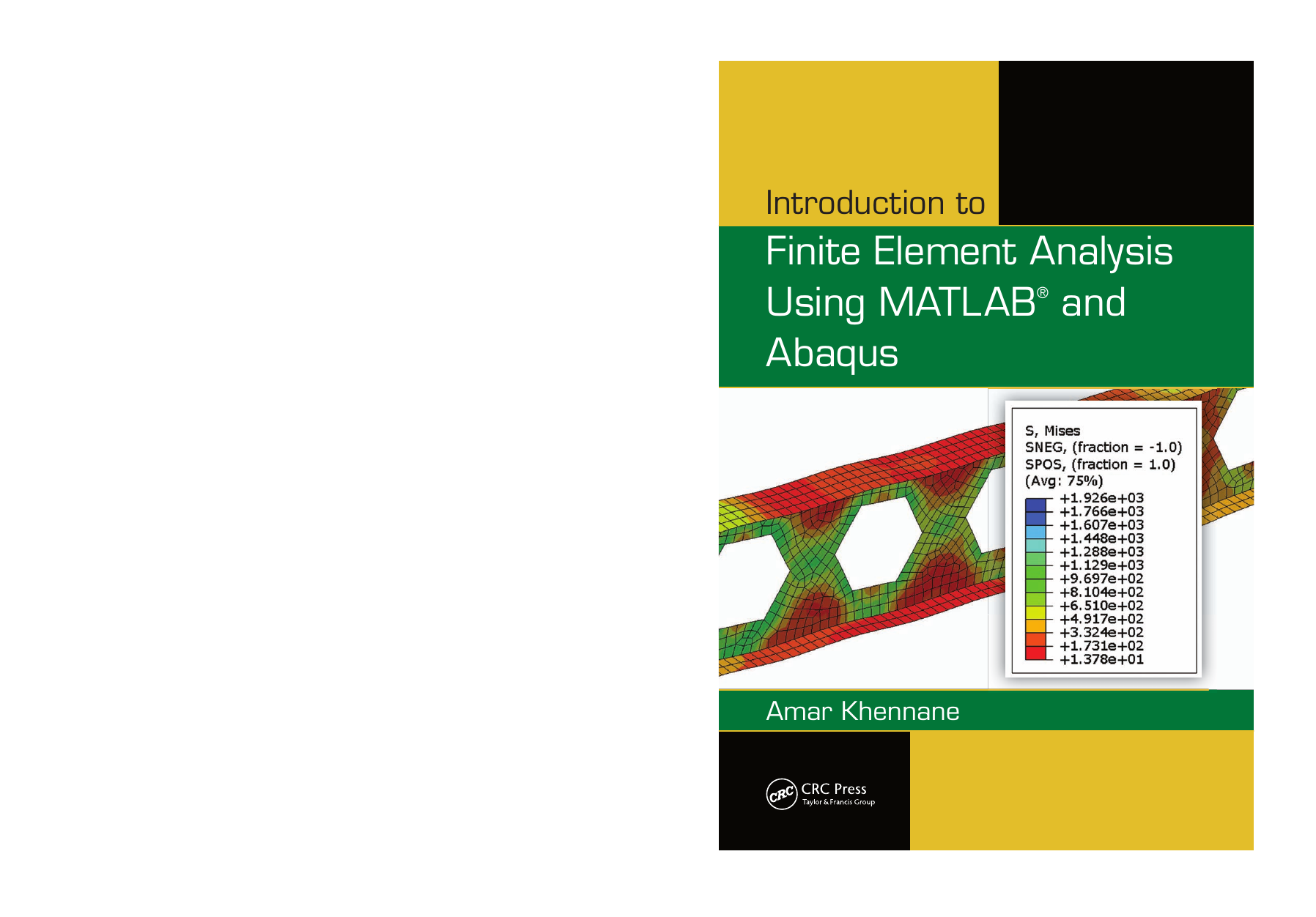
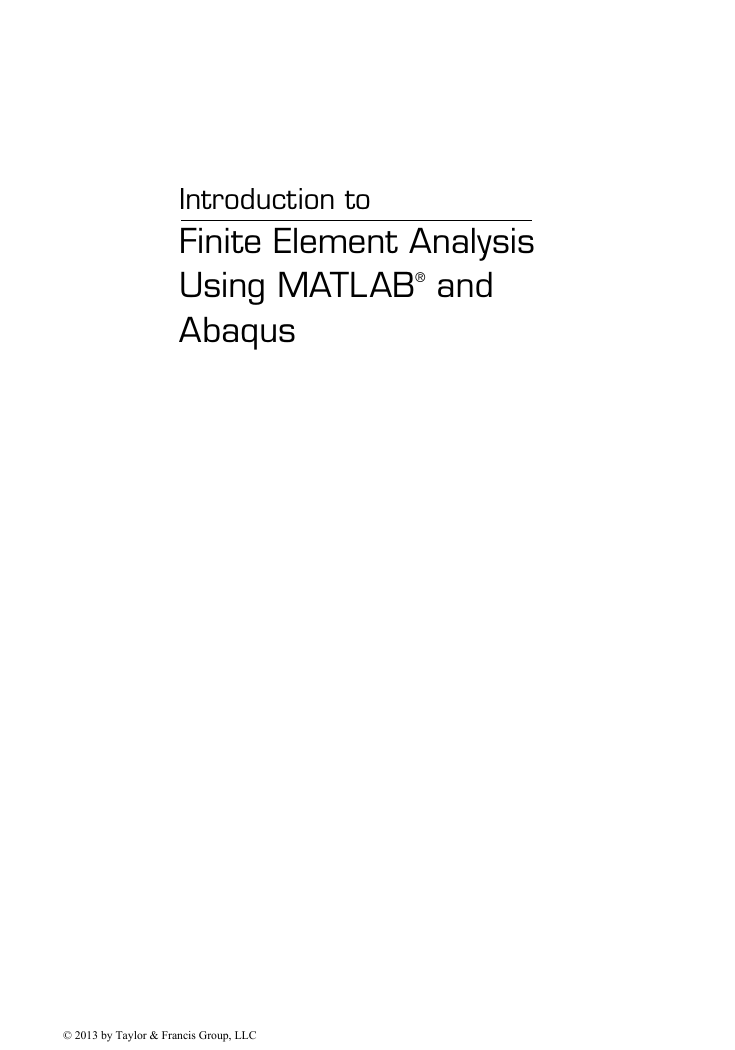

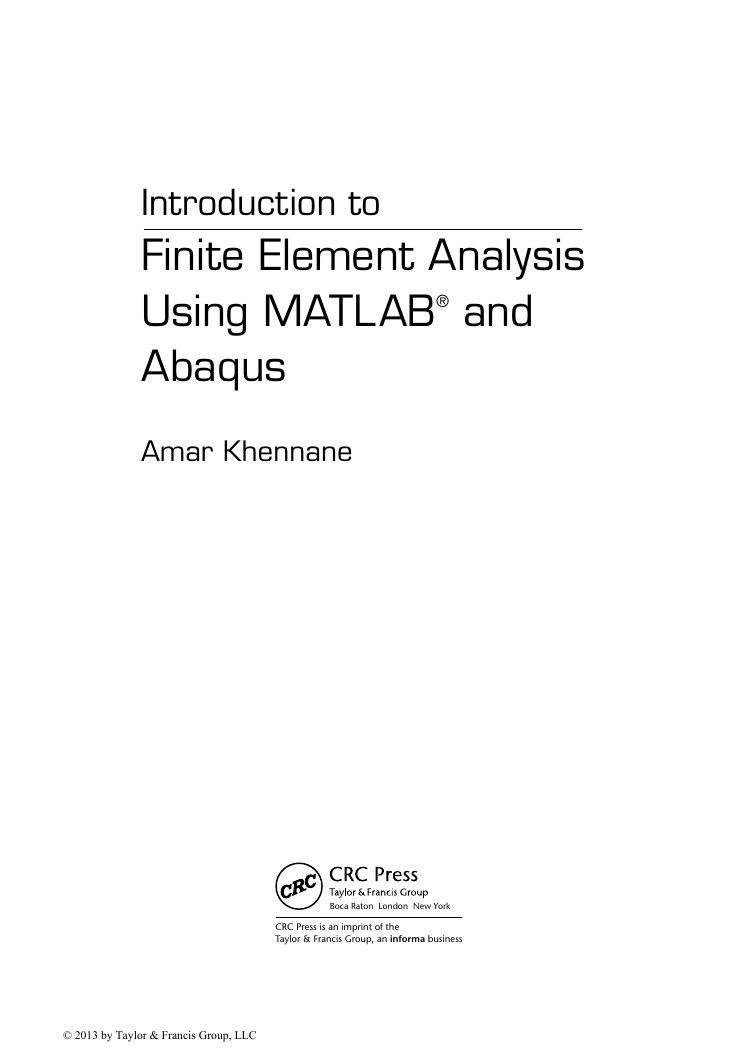
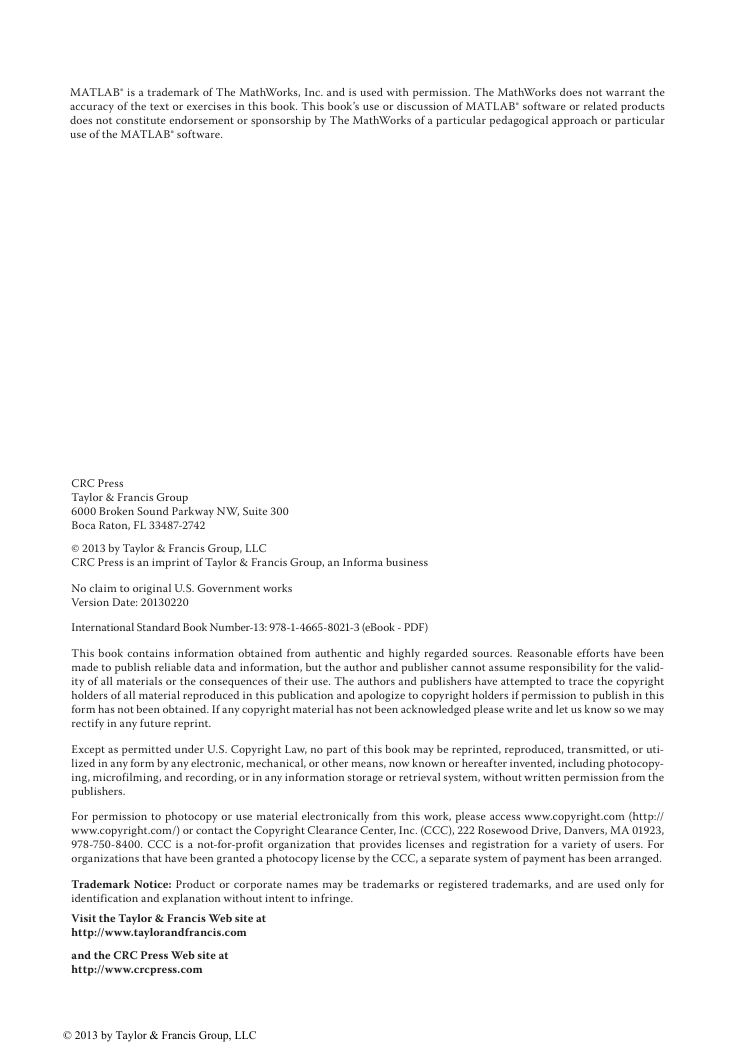
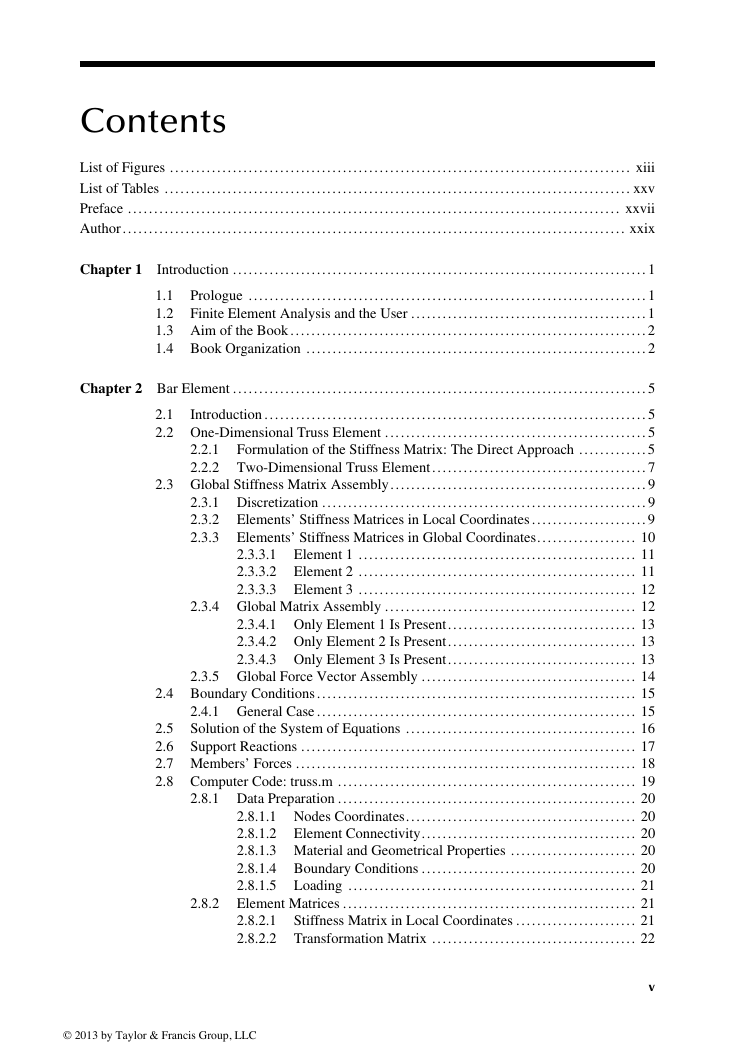
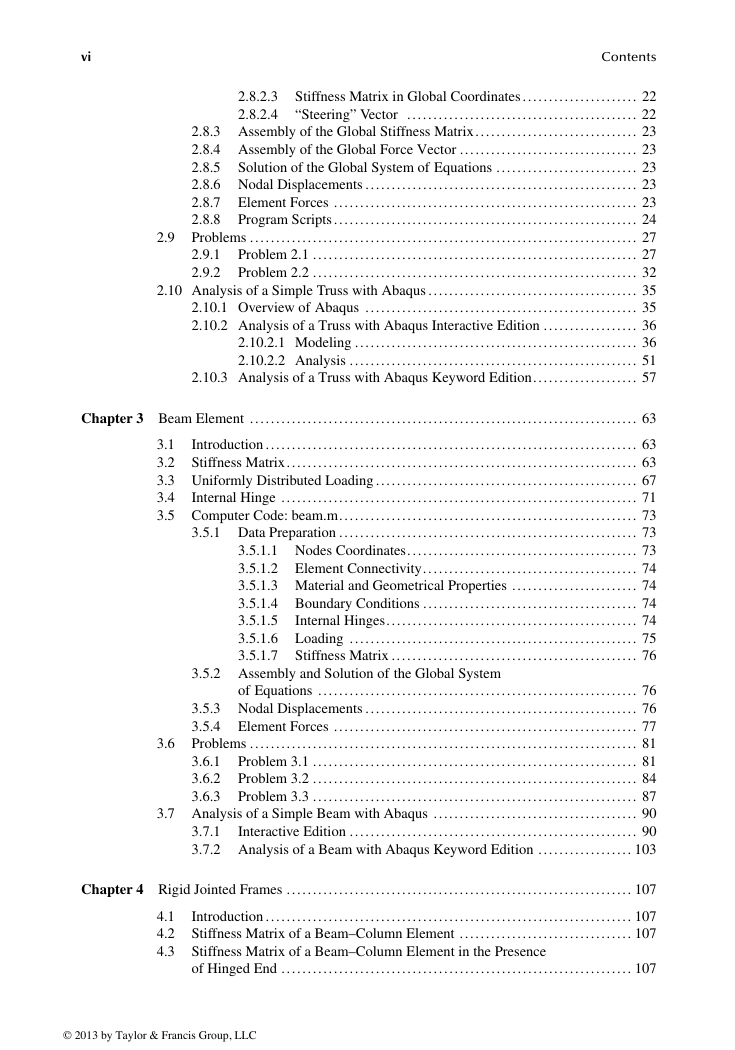








 2023年江西萍乡中考道德与法治真题及答案.doc
2023年江西萍乡中考道德与法治真题及答案.doc 2012年重庆南川中考生物真题及答案.doc
2012年重庆南川中考生物真题及答案.doc 2013年江西师范大学地理学综合及文艺理论基础考研真题.doc
2013年江西师范大学地理学综合及文艺理论基础考研真题.doc 2020年四川甘孜小升初语文真题及答案I卷.doc
2020年四川甘孜小升初语文真题及答案I卷.doc 2020年注册岩土工程师专业基础考试真题及答案.doc
2020年注册岩土工程师专业基础考试真题及答案.doc 2023-2024学年福建省厦门市九年级上学期数学月考试题及答案.doc
2023-2024学年福建省厦门市九年级上学期数学月考试题及答案.doc 2021-2022学年辽宁省沈阳市大东区九年级上学期语文期末试题及答案.doc
2021-2022学年辽宁省沈阳市大东区九年级上学期语文期末试题及答案.doc 2022-2023学年北京东城区初三第一学期物理期末试卷及答案.doc
2022-2023学年北京东城区初三第一学期物理期末试卷及答案.doc 2018上半年江西教师资格初中地理学科知识与教学能力真题及答案.doc
2018上半年江西教师资格初中地理学科知识与教学能力真题及答案.doc 2012年河北国家公务员申论考试真题及答案-省级.doc
2012年河北国家公务员申论考试真题及答案-省级.doc 2020-2021学年江苏省扬州市江都区邵樊片九年级上学期数学第一次质量检测试题及答案.doc
2020-2021学年江苏省扬州市江都区邵樊片九年级上学期数学第一次质量检测试题及答案.doc 2022下半年黑龙江教师资格证中学综合素质真题及答案.doc
2022下半年黑龙江教师资格证中学综合素质真题及答案.doc